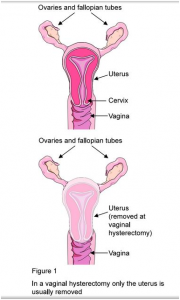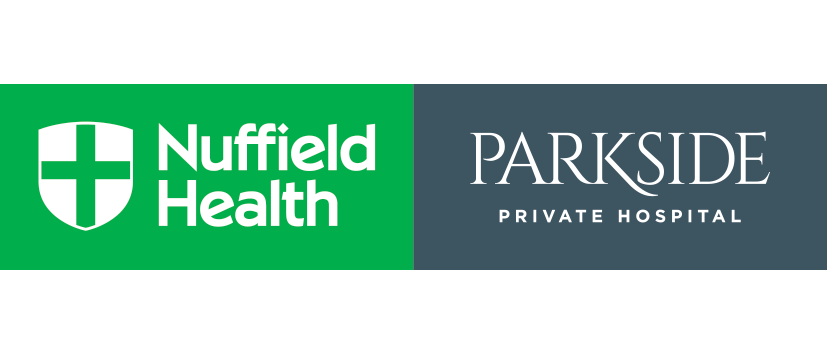Vaginal Hysterectomy
This page will provide you with information about having a vaginal hysterectomy. For further details, please speak to your consultant.
What is a vaginal hysterectomy?
During a vaginal hysterectomy, your womb and cervix will be removed through your vagina, rather than through an abdominal incision. Your ovaries may sometimes be removed in addition to your womb and cervix, but they will normally be left in place (see Figure 1).

The main reasons that some women decide to have a vaginal hysterectomy include painful and heavy periods, uterine prolapse and fibroids.
What are the benefits of having a vaginal hysterectomy?
This type of surgery can improve or cure your symptoms. After the operation you will no longer have periods.
What are the alternatives to surgery?
Regular pelvic floor exercises can help to ease symptoms of uterine prolapse. Heavy and painful periods can be treated by taking oral medications, the removal of only the lining of the womb, or by an IUD (intra-uterine device).
Depending on the position and size of your fibroids, you can be given medication to try and relieve the symptoms. Another option is uterine artery embolisation or to undergo surgery that can remove fibroids only.
What will happen during the operation?
- The surgeon will make an incision at the top of the vagina around your cervix in order to remove your cervix and womb.
- Typically, they will stitch the support ligaments of your womb to the top of the vagina. This will reduce the chances of a prolapse in the future.
- The operation is usually carried out under general anaesthesia.
- The procedure should last approximately 45 minutes.
Risks and complications
Any risks or complications will be discussed in advance of your treatment with your expert consultant.
Recovery
Even though you should be able to go home within one to three days, you should make sure you rest for at least 14 days, whilst continuing the exercises you were shown in hospital. After 4-6 weeks you should be allowed to return to work, as long as the type of work you carry out does not put a strain on your stitches. After 8-12 weeks, you should be feeling back to normal. Gentle and frequent exercises can help speed up the process, but you should always ask your consultant before beginning exercising.
Summary
A hysterectomy can drastically improve symptoms, but should be seen as a ‘last resort’ after simpler treatments have failed.
References:
EIDO Healthcare Limited – The operation and treatment information on this website is produced using information from EIDO Healthcare Ltd and is licensed by Aspen Healthcare.
The information should not replace advice that your relevant health professional would give you.
Vaginal Hysterectomy Consultants
Qualifications
MB.BS (Lon) BSc(Hons) MRCOG
Clinical Interests
Childbirth injury
Urinary incontinence in women
Uterine prolapse
Vaginal prolapse
Repeat prolapse or incontinence after...
Qualifications
MB.BS (Lon) BSc(Hons) MRCOG
Clinical Interests
Childbirth injury
Urinary incontinence in women
Uterine prolapse
Vaginal prolapse
Repeat prolapse or incontinence after...
Qualifications
FRCOG M.D. MRCOG MA MBBS BA(Hons)
Clinical Interests
Menopause
Problem periods
Abnormal bleeding
Polycystic ovarian syndrome
Premenstrual syndrome
Fibroids
Pelvic pain
Endometriosis
Fertility
HRT
Management...
Qualifications
FRCOG M.D. MRCOG MA MBBS BA(Hons)
Clinical Interests
Menopause
Problem periods
Abnormal bleeding
Polycystic ovarian syndrome
Premenstrual syndrome
Fibroids
Pelvic pain
Endometriosis
Fertility
HRT
Management...
Qualifications
MBBCh MRCOG
Clinical Interests
Abnormal bleeding
Outpatient hysteroscopy
Fibroids
Menopause
Early pregnancy care
Pelvic pain
Infertility
Qualifications
MBBCh MRCOG
Clinical Interests
Abnormal bleeding
Outpatient hysteroscopy
Fibroids
Menopause
Early pregnancy care
Pelvic pain
Infertility




